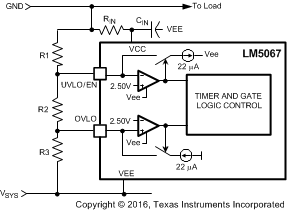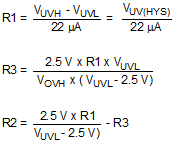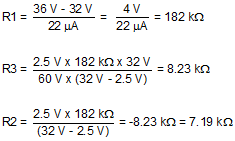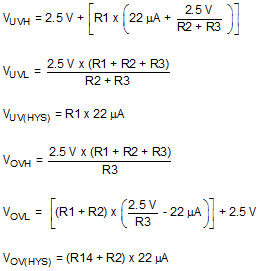ZHCSLQ5D October 2007 – August 2020 LM5067
PRODUCTION DATA
- 1 特性
- 2 应用
- 3 说明
- 4 Revision History
- 5 Device Comparison
- 6 Pin Configuration and Functions
- 7 Specifications
- 8 Detailed Description
-
9 Application and Implementation
- 9.1 Application Information
- 9.2
Typical Application
- 9.2.1 Design Requirements
- 9.2.2 Detailed Design Procedure
- 9.2.3 Application Curves
- 10Power Supply Recommendations
- 11Layout
- 12Device and Documentation Support
- 13Mechanical, Packaging, and Orderable Information
9.2.2.7.1 Option A:
The configuration shown in Figure 9-6 requires three resistors (R1-R3) to set the thresholds.
 Figure 9-6 UVLO and OVLO Thresholds Set By R1-R3
Figure 9-6 UVLO and OVLO Thresholds Set By R1-R3The procedure to calculate the resistor values is as follows:
- Determine the upper UVLO threshold (VUVH) to enable Q1, and the lower UVLO threshold (VUVL) to disable Q1.
- Determine the upper OVLO threshold (VOVH) to disable Q1.
- The lower OVLO threshold (VOVL), to enable Q1, cannot be chosen in advance in this case, but is determined after the values for R1-R3 are determined. If VOVL must be accurately defined in addition to the other three thresholds, see Option B below.
The resistors are calculated as follows:

The lower OVLO threshold is calculated from:

As an example, assume the application requires the following thresholds: VUVH = -36V, VUVL = -32V, VOVH = -60V.

The lower OVLO threshold calculates to -55.8V, and the OVLO hysteresis is 4.2V. Note that the OVLO hysteresis is always slightly greater than the UVLO hysteresis in this configuration.
When the R1-R3 resistor values are known, the threshold voltages and hysteresis are calculated from the following:

Ensure the voltages at the UVLO and OVLO pins do not exceed the Absolute Maximum ratings for those pins when the system voltage is at maximum.